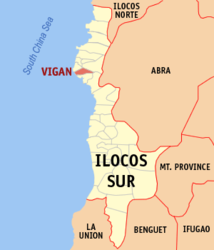Vigan City
| City of Vigan | ||
| Location of Vigan City in the province of Ilocos Sur | ||
|---|---|---|

|
||
| Basic data | ||
| Region : | Ilocos region | |
| Province : | Ilocos Sur | |
| Barangays : | 39 | |
| District: | 1. District of Ilocos Sur | |
| PSGC : | 012934000 | |
| Income class : | 5th income bracket | |
| Households : | 9193 May 1, 2000 census
|
|
| Population : | 53,879 August 1, 2015 census
|
|
| Population density : | 4898 inhabitants per km² | |
| Area : | 11 km² | |
| Coordinates : | 17 ° 35 ' N , 120 ° 23' E | |
| Postal code : | 2700 | |
| Area code : | +63 77 | |
| Mayor : | Ferdinand C. Medina | |
| Website: | www.vigancity.gov.ph | |
| Geographical location in the Philippines | ||
|
|
||
Vigan City (美 岸, Hokkien , Pe̍h-ōe-jī : bîgán, Pinyin : měiàn) is the capital of the Philippine province of Ilocos Sur . The city is located on the western coast of the main island of Luzon on the South China Sea , 400 km north of Manila . As the oldest existing Spanish colonial city of Vigan in 1999 became the UNESCO - World Heritage appointed. The Abra River flows into the sea south of Vigan City .
history
The city was originally located on an island in a large delta formed by the Abra , Mestizo and Govantes rivers .
The coastal city had a natural harbor and was an important trading center in northern Luzon in the pre-colonial period. There were trade relations with mainland China, Southeast Asia, Taiwan, Japan and Korea. It was a hustle and bustle in the port of Vigan at this time, in addition to junks also the local Balangays anchored . Because of its location, the area (美 岸, Hokkien (Pe̍h-ōe-jī transcription): bîgán, Mandarin Chinese (Pinyin transcription): měiàn) was baptized in German enchanting bank . The most important products of import and export were porcelain, ivory, silk and beeswax. Later, when the Spanish expanded their sphere of influence from the American continent to Asia in the 16th century, Vigan served as one of the more important ports of the colonial empire in Asia. In 1572 eight Spanish ships landed under the conquistador Juan de Salcedo on the coast of Vigans to usher in a campaign of conquest and Christianization. There were soldiers and Catholic priests on board. The Spaniards recognized Vigan's location, which was favorable for domestic and foreign trade, and after their conquest rebuilt the city based on the Spanish model.
In the course of the British invasion of the Philippines , at the end of the Seven Years' War , there were uprisings in the region in 1762/63. These were led by Diego Silang and his wife Gabriela . Her greatest success was the capture of Vigan in 1763.
The delta of the three rivers silted up in the 19th century and cut the city off from the sea, which led to a loss of importance for Vigan in inland trade.
During the Spanish colonial rule the city in honor of the son of was Philip II. In Villa Fernandina renamed. As the city grew in size during the colonial period, it became the seat of the Archdiocese of Nueva Segovia and renamed Ciudad Fernandina de Vigan , city of Ferdinand of Vigan.
Buildings
The city center has hardly changed since the Spanish colonial era. The three-aisled cathedral from 1574, which was built in a compact construction because of the many earthquakes, is particularly outstanding. Every year, during Semana Santa , colorful Carozas accompany the Catholic procession. Only a few influential families of Vigans are allowed to present the two-meter tall figures of saints, bless them in the cathedral and lead the procession of 5000 believers. The Archbishop's Palace was built in 1793 and is the religious and political administrative center of the province.
The city's former port has become a water lily pond over the centuries. Around 130 of the stately Spanish colonial houses have been preserved here and show typical Asian and Spanish features. They have large windows and sliding shutters that protect from the sun. Massive stone walls should protect against the numerous earthquakes. The front doors were wide enough for the horse-drawn carriage to go straight into the house. The practical clamshell panes shape Vigan's window world and are reminiscent of the charm of medieval Luzon. They dampen the light of the tropical sun well and comfortably air-condition the living room, which is up to 100 m² in size. Since being declared a World Heritage Site, the villas have been renovated and refurbished.
statistics
In 2015 the city had 53,879 inhabitants with an area of 25.11 km². The residents are very young. There is a small airport in Baranggay Mindoro.
Sons of the city
- Jose Burgos , a Filipino national hero
- Elpidio Quirino , the sixth President of the Philippines
Barangays (districts)
Vigan is divided into the following 39 barangays :
|
|
|
Colleges
literature
- Vigan . In: Encyclopædia Britannica . 11th edition. tape 28 : Vetch - Zymotic Diseases . London 1911, p. 58 (English, full text [ Wikisource ]).
Web links
Individual evidence
- ↑ Historic City of Vigan. UNESCO World Heritage Center, accessed August 24, 2017 .
- ↑ a b Heritage City of Vigan

